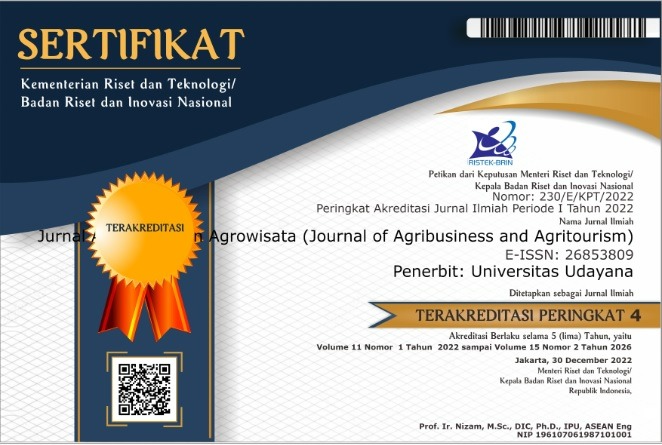Faktor-Faktor yang Mempengaruhi Produktivitas Tenaga Kerja Penyadap Karet PT Melania Indonesia Mas Estate (Studi Kasus di PT Melania Indonesia Mas Estate Desa Mainan, Kecamatan Sembawa, Kabupaten Banyuasin, Provinsi Sumatera Selatan
Abstract
Factors Affecting Labor Productivity of Rubber Tapping PT. Melania Indonesia Mas Estate (Case Study at PT Melania Indonesia Mas Estate Toy Village, Sembawa District, Banyuasin Regency, South Sumatra)
This study aims to determine the productivity of the tapping labor force and the factors that influence the productivity of the rubber tapping workforce of PT Melania Indonesia. This analysis uses independent variables, namely wages, work experience and incentives. The dependent variable is the productivity of tapping labor. The sample of this research is the rubber tapper workers of PT Melania Indonesia as many as 78 respondents. Statistical method using Multiple Linear Regression Analysis using SPSS 24 program, with hypothesis testing statistical test t. The results of the analysis of data from the t test showed that the wage variable (X1) had a positive and significant effect on productivity with a Sig value of 0.009 <0.05, the work experience variable (X2) and incentives (X3) also had a positive and significant effect on productivity with a Sig value. 0.000 < 0.05 and 0.000 < 0.05. The magnitude of the coefficient of determination R2 is 0.950. This means that the tapping labor productivity variable is influenced by the variables of wages, work experience and incentives by 95%. The conclusion of this study is that the variables of wages, work experience and incentives are factors that affect the productivity of rubber tappers in PT Melania Indonesia's plantation. In this case, plantation companies are expected to pay attention to stability in the provision of wages, work experience and incentives, this is because these variables are the driving factors that affect the workforce in achieving company goals.
Downloads
References
Dwi Nugroho, S. (2018). Pengaruh Pengalaman Kerja dan Gaji Terhadap Produktivitas Kerja Karyawan pada PT.Dan Liris (Bagian Divisi Garmen Konveksi IV) di Sukoharjo. e-jurnal Pemerintah Integratif, Vol.6, No.3.
Ediyanto.R. dan Maspur. 2008. Analisis Produktivitas Tenaga Kerja dan Tingkat Upah Buruh Penyadap Karet Di PTPN XII Kebun Kalirejo Banyuwangi. Agritrap Jurnal IlmuIlmu Pertanian. Fakultas Pertanian Universitas Muhammadiyah Jember.
Ghozali, Imam. 2011. “Aplikasi Analisis Multivariate Dengan Program SPSS”. Semarang: Badan Penerbit Universitas Diponegoro.
Hasanah, Erni Ummi dan Widowati, Puri. 2011. Analisis Produktivitas Tenaga Kerja pada Industri Rumah Tangga Krecek di Kelurahan Segoroyoso. Efektif Jurnal Bisnis dan Ekonomi, vol.2, no.2, hal. 169-182.
Lesmana, Dina. 2007. “Kinerja Balai Penyuluhan Pertanian”. Fakultas Pertanian Universitas Mulawarman.
Nurfiat, Nashahta , Ardhiaty , & Rustariyuni, Surya, Dewi . (2018). Pengaruh Upah Dan Teknologi Terhadap Produktivitas Dan Penyerapan Tenaga Kerja Pada Industri Mebel Di Kota Denpasar. Jurnal PIRAMIDA, Vol XIV No. 1, 31-38.
Solow, R.M. 1979. Another Possible Source Of Wage Stickiness. Journal Of Macroeconomics, 1, pp: 79-82.
Sujarweni, V. Wiratna. (2015). “SPSS untuk Penelitian”. Yogyakarta: Pustaka Baru Pers
Vendy Aries Martcahyo dkk.. (2011), Pengaruh Pelatihan Kerja, Jaminan Sosial dan Insentif Terhadap Kinerja Karyawan Bagian Produksi PT. Fumira, Semarang : Jurnal Ilmu Administrasi Bisnis Vol. 1 hal 14.







